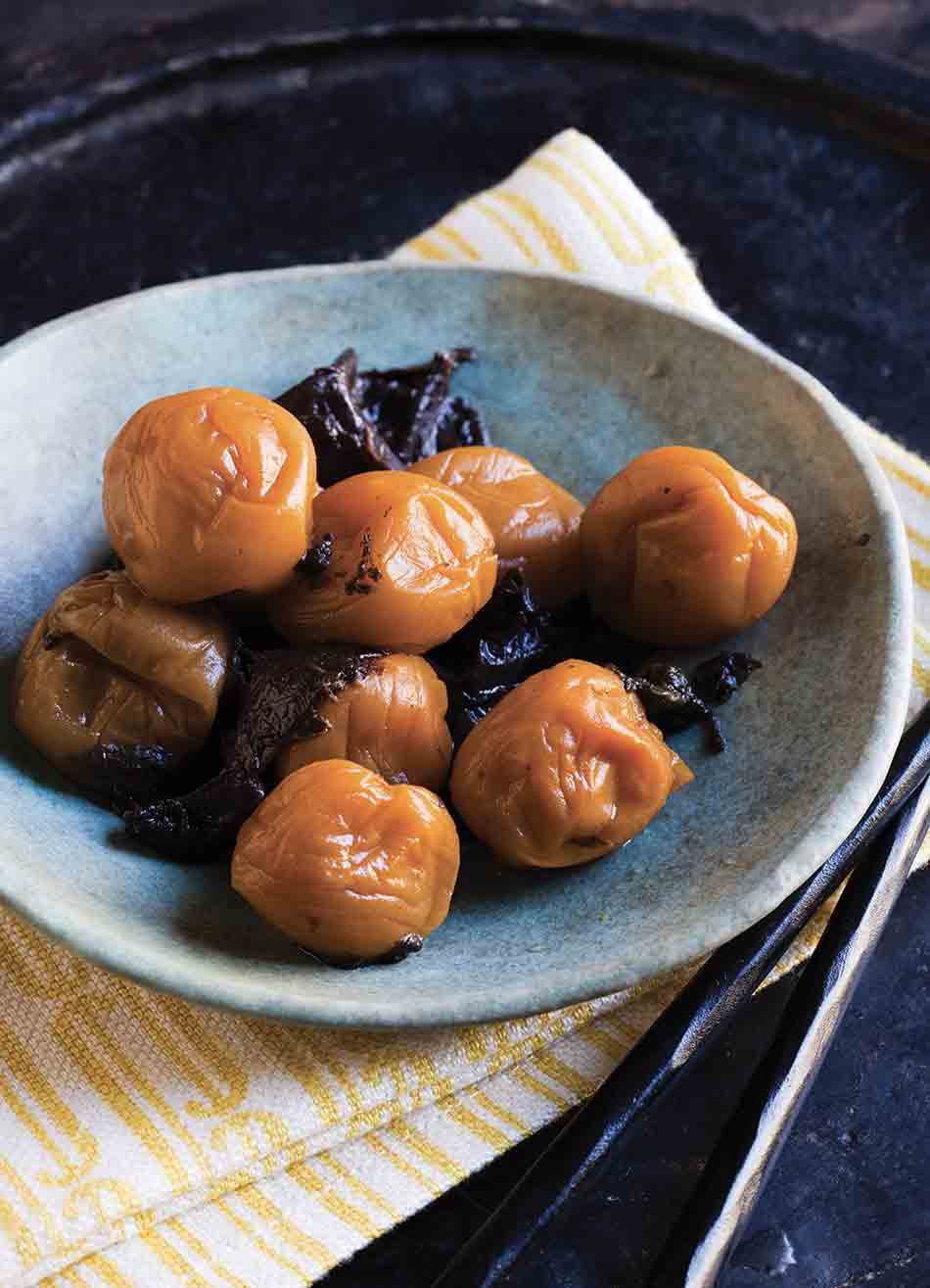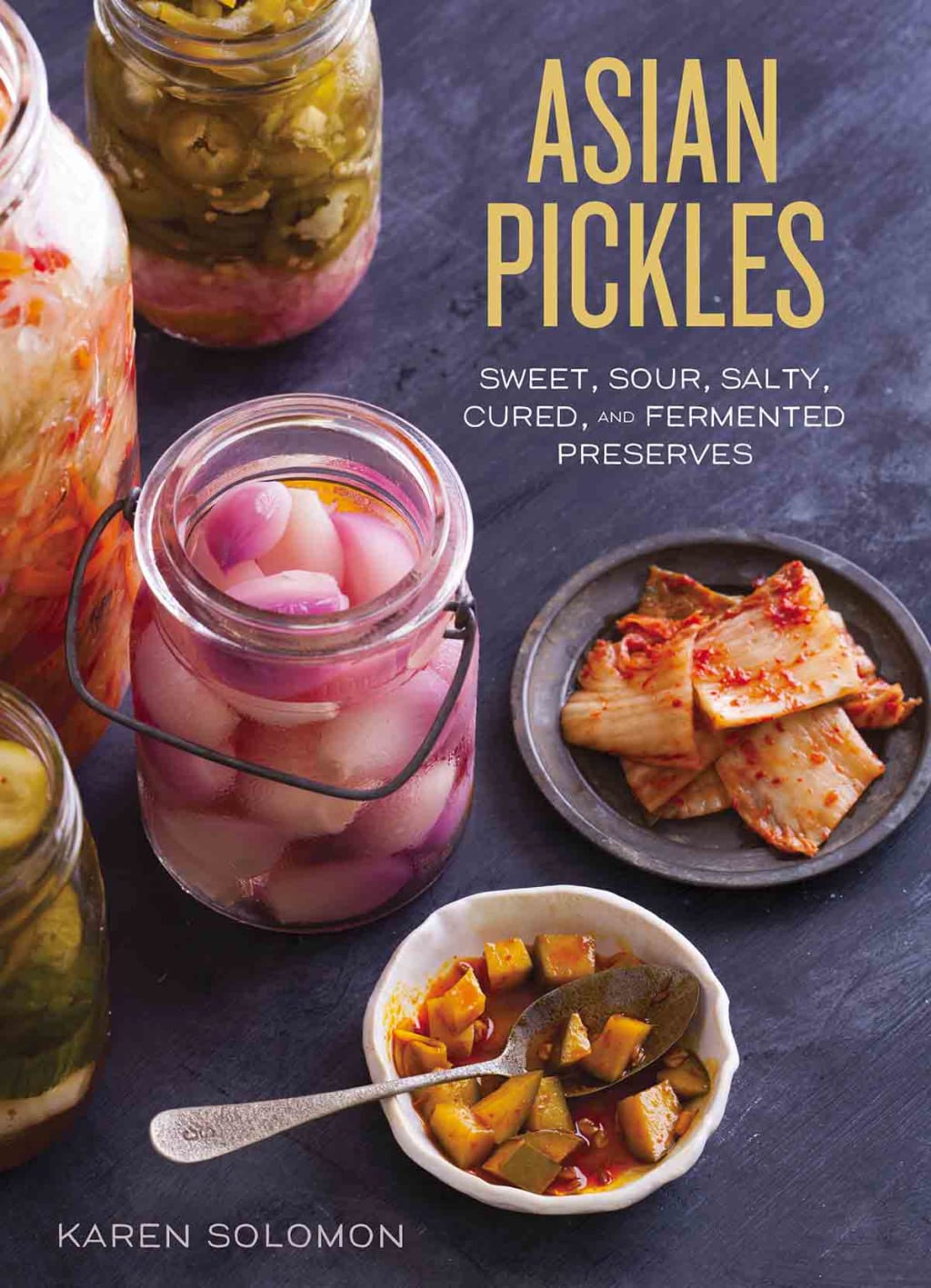Recipe for Umeboshi by Karen Solomon
Ume are not like the plums found in the Western world. Poisonous when raw, the Japanese pickle them to make them safe for consumption.

© 2014 by Jennifer Martiné
In Japan, pickled vegetables are known as tsukemono and are eaten in the middle of a meal or as an aperitif. Karen Solomon shares her recipe for umeboshi, or pickled plums, in her book Asian Pickles, which contains over 75 recipes for homemade preserved foods. Umeboshi (from ume, ‘plum’ and boshi, ‘dried’) are tsukemono plums with an acidic, salty flavour.
Very different to the plums found in the West, ume is the fruit of the Japanese apricot tree and conceals a surprising quality: it is poisonous when raw. To make it safe for consumption, the Japanese found a solution. The plum has to be pickled with red shiso leaves, an aromatic plant, that give it a burgundy colour, before removing the salt and drying it.
Ingredients
• TIME: 3 TO 7 WEEKS • MAKES ABOUT 1.5 L UMEBOSHI and AND 750 ML UMEZU •
1 kg ume or mature but unripened apricots, washed
240 g kosher salt
15 to 20 red shiso leaves, fresh or preserved in salt (optional)
Method
Place the plums in a 4- to 10-litre vessel made of ceramic, glass, or food-grade plastic and cover them with 5 cm of water. Cover with a weighted plate or a plastic bag filled with water to keep them submerged. Let them soak for eight hours or overnight.
Drain the plums and return to the container, sprinkle with half of the salt, and toss to combine. Sprinkle the remaining salt evenly over the tops of the plums. Cover the plums with a drop lid—a pot lid, plate, or plastic container lid the right size to fit inside the pickling vessel without touching the sides. Place 1 kg of weight (cans, rocks, or whatever is suitable and handy) on top of the drop lid. Cover the top of the container loosely with a clean cloth to let air flow in but keep out insects and debris. Store at room temperature in a cool, dark place.
Check the plums after two days. Liquid will have started to form in the bottom; this is umezu (plum “vinegar”), a very desirable substance for seasoning, pickling vegetables, and marinating. Leave it where it is for now—the ume need this precious liquid. Stir the plums every couple of days for two to three weeks, replacing the drop lid and weights each time, until they are completely covered in liquid. If tiny spots of mould form on the surface, remove them with a clean finger or a paper towel and discard.
If you’re using the shiso (which will colour the plums and lend them its flavour), lay the cleaned shiso leaves evenly over the top of the plums to cover them completely, then press down firmly. Either way, replace the lid and weights and leave in a cool, dark place for a couple more days.
Once the plums are covered completely in their own brine, remove the drop lid and the weight and cover the plums loosely with a lid or kitchen towel, allowing for some airflow. Return the vessel to its cool, dark place and allow the plums to continue to brine for an additional one to four weeks, tasting once a week, until they have reached the level of puckery tartness that you desire.
When the umeboshi are fermented to your satisfaction, drain and reserve the umezu and store it in a pouring bottle at room temperature. Use anywhere you’d normally use vinegar (being mindful that additional salt won’t usually be necessary) or soy sauce. The umezu will last almost indefinitely. If you like, you can add more red shiso to the umezu to enhance its colour and flavour.
Spoon the plums and the shiso leaves into clean jars with secure lids; cover and refrigerate. Share with your friends. Kept refrigerated, these plums will keep for at least a year—until the next ume crop!
Asian Pickles (2014), a recipe book by Karen Solomon, is published by Ten Speed Press, and is available only in English.
Pickled vegetables are one of the hallmarks of Asian cuisine. Asian Pickles contains, alongside recipes, various explanations about this culture, and simple but astute tips for those interested in trying their hand at this food preservation method on a long-term basis.
Karen Solomon is a food writer and culinary instructor. She specialises in the different methods of food preservation: making preserves, canning, drying, and smoking. Asian Pickles is her third book after Can It, Bottle It, Smoke It and Jam It, Pickle It, Cure It.
“Reprinted with permission from Asian Pickles: SWEET, SOUR, SALTY, CURED, AND FERMENTED PRESERVES FROM KOREA, JAPAN, CHINA, INDIA, AND BEYOND by Karen Solomon. Copyright © 2014. Photographs copyright © 2014 by Jennifer Martiné. Published by Ten Speed Press, an imprint of Penguin Random House.”

© 2014 by Jennifer Martiné
TRENDING
-
A House from the Taisho Era Reveals Its Secrets
While visiting an abandoned building, Hamish Campbell discovered photographs the owner had taken of the place in the 1920s.

-
The Taboo-Breaking Erotica of Toshio Saeki
The master of the 1970s Japanese avant-garde reimagined his most iconic artworks for a limited box set with silkscreen artist Fumie Taniyama.

-
With Meisa Fujishiro, Tokyo's Nudes Stand Tall
In the series 'Sketches of Tokyo', the photographer revisits the genre by bringing it face to face with the capital's architecture.

-
Masahisa Fukase's Family Portraits
In his series ‘Family’, the photographer compiles surprising photos in which he questions death, the inescapable.

-
Hajime Sorayama's Futuristic Eroticism
The illustrator is the pioneer for a form of hyperrealism that combines sensuality and technology and depicts sexualised robots.





